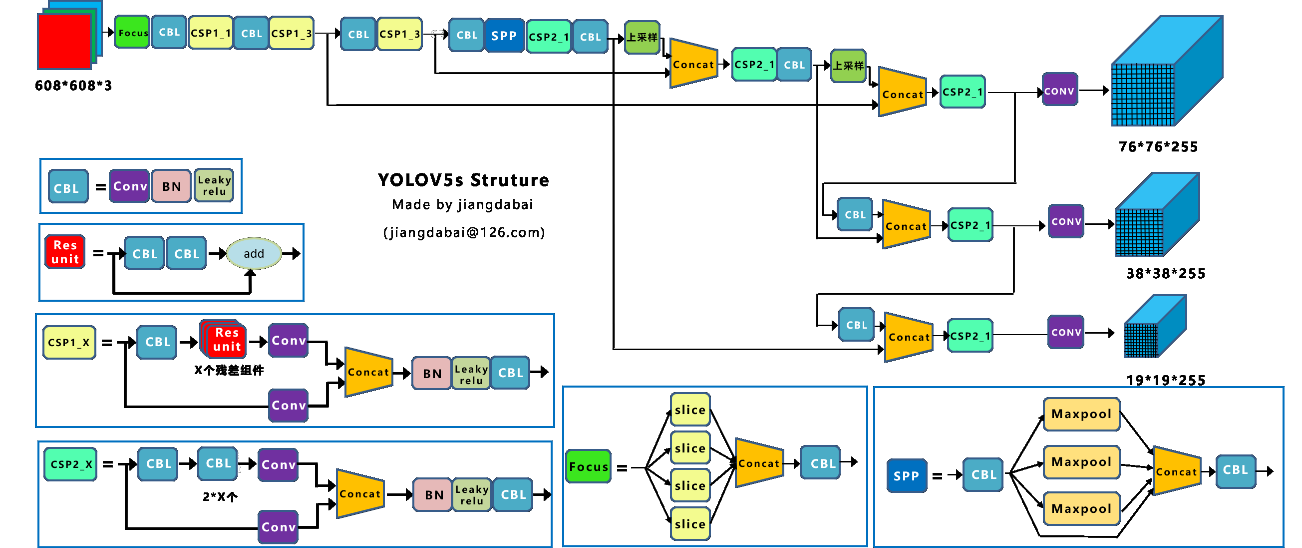构建YOLO与神经网络的知识体系:全面掌握AI技术栈
发布时间: 2024-08-17 19:30:20 阅读量: 37 订阅数: 41 


# 1. 人工智能基础**
人工智能(AI)是一门研究如何使计算机模拟人类智能的学科。它涉及到机器学习、自然语言处理、计算机视觉等多个领域。
机器学习是AI的核心技术,它使计算机能够从数据中学习,而无需明确编程。机器学习算法可以识别模式、预测结果并做出决策。
神经网络是机器学习中的一种强大算法,它受到人脑结构的启发。神经网络由相互连接的节点组成,称为神经元。这些神经元处理输入数据并产生输出,类似于人脑中的神经元。
# 2. 神经网络理论与实践**
**2.1 神经网络的基本概念**
**2.1.1 神经元的结构和功能**
神经元是神经网络的基本单元,其结构类似于生物神经元。它包含以下组件:
- **输入:** 接收来自其他神经元的信号。
- **权重:** 用于调节输入信号强度的值。
- **激活函数:** 对加权输入进行非线性变换,产生神经元的输出。
神经元的输出通过突触连接到其他神经元的输入。突触的权重决定了神经元之间连接的强度。
**2.1.2 神经网络的层级结构**
神经网络通常由多个层级的神经元组成。每一层的神经元从上一层接收输入,并将其输出传递给下一层。
神经网络的层级结构可以分为:
- **输入层:** 接收原始数据。
- **隐藏层:** 提取数据的特征和模式。
- **输出层:** 产生最终预测或决策。
**2.2 神经网络的训练与优化**
**2.2.1 损失函数和优化算法**
神经网络的训练涉及调整权重以最小化损失函数。损失函数衡量模型预测与真实标签之间的差异。
常用的优化算法包括:
- **梯度下降:** 沿损失函数的负梯度方向更新权重。
- **动量:** 在梯度下降的基础上添加动量项,加速收敛。
- **RMSprop:** 适应性学习率优化算法,针对每个权重使用不同的学习率。
**2.2.2 训练数据的准备和预处理**
训练神经网络需要高质量的训练数据。数据预处理步骤包括:
- **数据清理:** 删除缺失值和异常值。
- **特征工程:** 提取和转换数据中的相关特征。
- **数据归一化:** 将数据值缩放或标准化到特定范围内。
**2.3 神经网络的应用**
**2.3.1 图像识别和分类**
神经网络在图像识别和分类任务中表现出色。它们可以学习图像中的模式和特征,并将其分类为不同的类别。
**2.3.2 自然语言处理**
神经网络也广泛应用于自然语言处理任务,例如:
- **文本分类:** 将文本文档分类到不同的类别。
- **情感分析:** 分析文本的情感极性。
- **机器翻译:** 将文本从一种语言翻译到另一种语言。
**代码示例:**
```python
import tensorflow as tf
# 创建一个神经网络模型
model = tf.keras.Sequential([
tf.keras.layers.Dense(units=10, activation='relu', input_shape=(784,)),
tf.keras.layers.Dense(units=10, activation='relu'),
tf.keras.layers.Dense(units=10, activation='softmax')
])
# 编译模型
model.compile(optimizer='adam', loss='sparse_categorical_crossentropy', metrics=['accuracy'])
# 训练模型
model.fit(x_train, y_train, epochs=10)
# 评估模型
model.evaluate(x_test, y_test)
```
**逻辑分析:**
此代码创建了一个三层神经网络模型,用于手写数字分类。
- 第一层是一个具有 10 个神经元的隐藏层,使用 ReLU 激活函数。
- 第二层是另一个具有 10 个神经元的隐藏层,也使用 ReLU 激活函数。
- 输出层具有 10 个神经元,使用 softmax 激活函数,产生概率分布,表示输入图像属于每个类别的可能性。
模型使用 Adam 优化器和稀疏分类交叉熵损失函数进行训练。它在训练和测试数据集上进行评估,以衡量其准确性。
# 3. YOLO目标检测算法**
### 3.1 YOLO算法的原理和结构
#### 3.1.1 单次卷积神经网络
YOLO(You Only Look Once)算法是一种单次卷积神经网络,它将目标检测任务简化为一个回归问题。与传统的目标检测算法不同,YOLO算法在单个神经网络中同时预测目标的类别和位置。
#### 3.1.2 Bounding Box的预测
YOLO算法将输入图像划分为一个网格,每个网格单元负责预测该区域内的目标。每个网格单元预测一个Bounding Box(边界框),表示该区域内目标的位置和大小。
### 3.2 YOLO算法的训练和评估
#### 3.2.1 训练数据集的制作
YOLO算法的训练需要一个包含图像和目标标注的训练数据集。标注通常包括目标的类别和Bounding Box的位置和大小。
#### 3.2.2 训练过程的监控和调整
YOLO算法的训练过程需要监控训练损失和验证精度。训练损失表示模型在训练集上的误差,验证精度表示模型在验证集上的准确性。通过调整超参数(如学习率和正则化参数)可以优化训练过程。
### 3.3 YOLO算法的应用
#### 3.3.1 实时目标检测
YOLO算法因其速度快而闻名,使其非常适合实时目标检测任务。它可以实时处理视频流并检测其中的目标。
#### 3.3.2 视频监控和分析
YOLO算法广泛应用于视频监控和分析中。它可以检测视频中的目标,并跟踪其运动和行为。这有助于识别可疑活动和提高安全性。
**代码示例:**
```python
import cv2
import numpy as np
# 加载 YOLO 模型
net = cv2.dnn.readNet("yolov3.weights", "yolov3.cfg")
# 加载输入图像
image = cv2.imread("image.jpg")
# 预处理图像
blob = cv2.dnn.blobFromImage(image, 1 / 255.0, (416, 416), (0, 0, 0), swapRB=True, crop=False)
# 将图像输入模型
net.setInput(blob)
# 前向传播
detections = net.forward()
# 后处理检测结果
for detection in detections[0, 0]:
confidence = detection[2]
if confidence > 0.5:
class_id = int(detection[1])
x, y, w, h = detection[3:7] * np.array([image.shape[1], image.shape[0], image.shape[1], image.shape[0]])
cv2.rectangle(image, (x, y), (x + w, y + h), (0, 255, 0), 2)
```
**逻辑分析:**
这段代码使用 OpenCV 加载 YOLO 模型并对输入图像进行目标检测。它首先预处理图像,然后将其输入模型进行前向传播。前向传播的输出是一个包含检测结果的张量。代码后处理检测结果,并绘制检测到的目标的边界框。
**参数说明:**
* `image`: 输入图像。
* `yolov3.weights`: YOLO 模型的权重文件。
* `yolov3.cfg`: YOLO 模型的配置文件。
* `blob`: 预处理后的图像。
* `detections`: 前向传播的输出张量。
* `confidence`: 目标检测的置信度。
* `class_id`: 目标的类别 ID。
*
0
0





